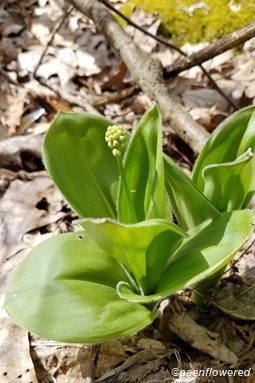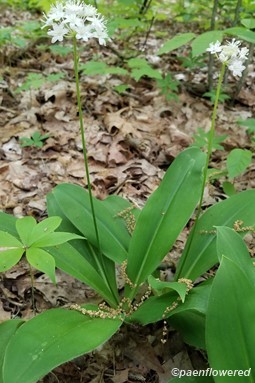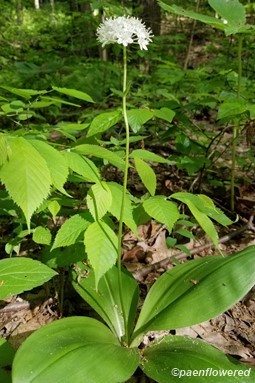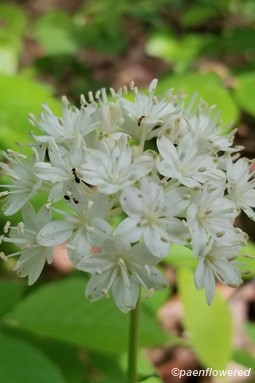Clintonia umbellulata
A white woodlily growing in the west of the state
Clintonia umbellulata speckled woodlily
A perennial herbaceous plant of forest habitats, this species can grow 11-24 inches tall and has 2-5 dark green basal leaves that are 7-12 inches long and 2-3 inches wide. It produces a single slightly hairy flower stalk up to 20 inches high that has a terminal cluster (umbel) with 10-25 outward-facing flowers. Each of these has 6 tepals (petals and sepals that look the same) that are white or greenish white. Often these are speckled with purplish brown or green marks. The tepals are 0.2-0.3 inches long. The flower has 6 stamens that are longer than the tepals.
The blooming period is May and June. The fruit that forms in summer is a black or deep blue berry 0.1-0.2 inches long containing 2-4 seeds. The berries are not poisonous but are foul-tasting at best. The leaves persist all summer. It is commercially available, but should be planted in an environment that it suitable for its growth.
This clintonia does best in rich soil in highland areas. It can grow at an altitude up to 3,300 feet. It is often found in the Laurel Mountains in Western PA. As a forest plant it is shade tolerant. It will spread slowly by the growth of underground rhizomes. Sometimes it forms large colonies, but these probably have taken many years to develop.
It is similar to Clintonia borealis (bluebead lily or yellow clintonia), but this more northern species has nodding flowers that have a yellowish tint. It is also sometimes mistaken for the unrelated Allium tricoccum, the wild leak. This species, however, has somewhat elongated nodding flowers and the leaves die back before the flowers form.
Habitat & Range
Grows in rich, moist woodlands. Prefers deep to partial shade and moist, well-drained, acidic soil.
Mostly found in the west of the state.
Range: Native to Appalachian mountain of eastern U.S. From wester New York southward to northern Georgia.
Wetland code: Not classified
Phenology
Flowers May through June. Blooming period is 2 to 3 weeks.
Fruits August to October.
Characteristics
Inflorescence terminal umbels without bracts with 6 to 25 flowers per umbel
Flowers outward-facing; perianth white with purple spots, 6 tepals 0.2-0.3″ long; 6 stames longer than tepals
Leaves basal only; 2 to 5; broadly elliptic, glossy, often leathery; margins ciliate; 7 to 12″ long, 2 to 3″ wide
Stem(Scape) slightly pubescent, erect, leafless; 6 to 20″ high
Rhizomes short, thick
Fruit small ovoid berries; black to deep blue when mature; 0.1 to 0.2″ long; 2 to 4 seeds per berry
Height 11 to 24 inches
Plant Codes
S-rank: S5 (Secure)
G-rank: G5 (Secure)
Ecology
Main pollinators are a variety of bees and flies. Small wildlife like birds and chipmunks feed on the berries, aiding in seed dispersal. Considered mildly toxic to humans.







Comments
Have you spotted this plant in your area? We'd love to hear about your experience! Share your comments or questions about the plant below. Comments are moderated before posting.